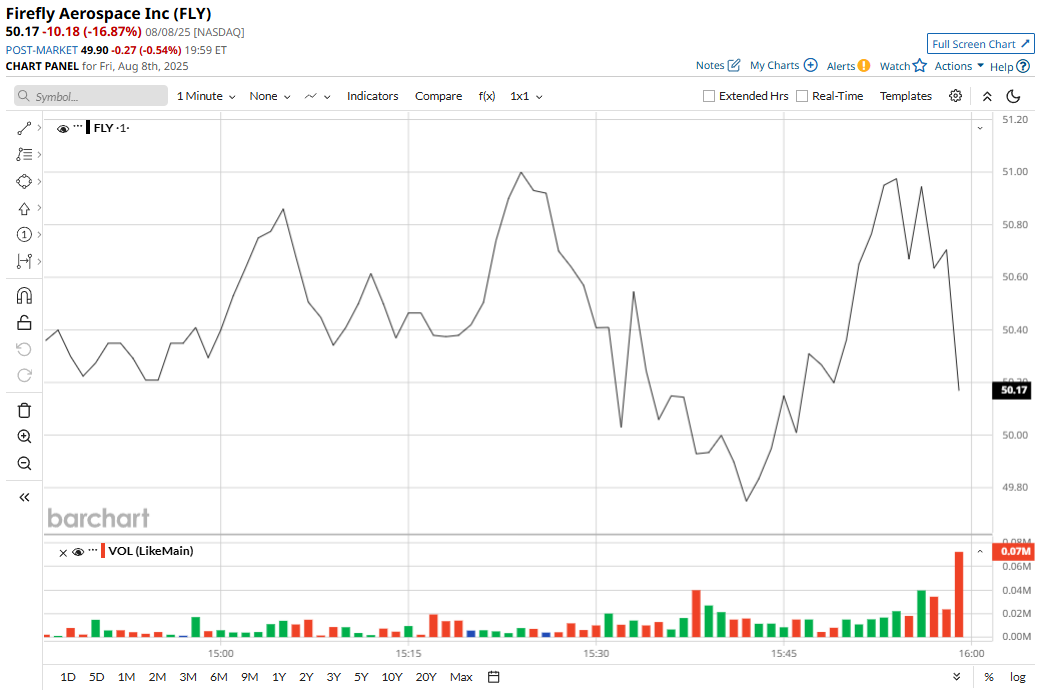Should You Buy FLY Stock after the Firefly Aerospace IPO?
The IPO market has been hot this year with companies like Circle (CRCL) and CoreWeave (CRWV) making blockbuster debuts. The latest to join this list is Firefly Aerospace (FLY), a space and defense technology company.
Closing at $60.35 on Aug. 7, much above its expected IPO price range of $41 to $43, shares of the company have corrected to trade near $54 currently. Thus, the question remains whether investors should look beyond the volatility of the share price and add Firefly to their portfolios. Let’s find out.

About Firefly Aerospace
Founded in 2014, Firefly develops small- to medium-lift rockets, lunar landers, and on-orbit infrastructure. Its mission is to make space missions affordable, reliable, and end-to-end, spanning Earth launch to lunar surface operations.
Firefly counts some key defense contractors such as L3Harris (LHX), Northrop Grumman (NOC), and Lockheed Martin (LMT) as its partners.
Increasing Revenues, Widening Losses
Firefly has seen its revenues multiply but losses widen as well over the past year.
For the quarter ended March 31, 2025, Firefly’s revenues stood at $55.86 million. This was almost 7 times higher than the previous year’s figure of $8.32 million. Spacecraft solutions revenue surged to $50.69 million from $7.01 million in the prior year, and launch revenue of $5.17 million was much higher than the prior year's $1.30 million as well.
In 2024, the company reported revenues of $60.79 million for the full year, up from $55.23 million in 2023.
Net losses widened to $60.09 million in the quarter from $52.77 million in the year-ago period. On a per stock basis, the losses were at $1.65 compared to $1.43 in the previous year. 2024 saw the company report losses of $231.13 million compared to $135.46 million in 2023.
Coming to its backlog, a key indicator of the demand for a company’s solutions, it stood at $1.12 billion at the end of March 31, 2025. This was double the previous year’s figure of $559.37 million.
Net cash flow from operating activities remained negative at $56.53 million for the quarter, lower than the previous year’s $60.58 million outflow. Overall, Firefly’s cash balance at the end of the quarter stood at $176.88 million, which was much higher than its short-term debt levels of about $8 million.
Does Firefly Have The Wings to Fly High?
The sky in which Firefly wishes to spread its wings is quite large. Overall, consulting major McKinsey sees space to be a whopping $1.8 trillion opportunity.
But the moot question is: Is Firefly's wings big enough?
The company’s portfolio is anchored by two primary launch vehicles, Alpha and Eclipse. Eclipse, developed in collaboration with Northrop Grumman, is capable of carrying payloads of about 16,000 kgs, while Alpha supports payloads of about 1,000 kgs. Beyond launch services, revenue streams are also derived from its spacecraft solutions segment. This includes the Blue Ghost Lander, designed for lunar surface missions, and Elytra, intended for applications such as space domain awareness and other mission-critical activities.
Notably, the addressable market for these offerings is expanding rapidly, propelled by growing demand for satellites serving both commercial and defense purposes. Growth is also underpinned by renewed strategic interest in defense capabilities in space and an accelerating push toward broader space exploration initiatives. These include potential ventures in extraterrestrial resource extraction and space-based energy generation.
Firefly has also positioned itself prominently within the space industry by claiming the first successful commercial lunar landing. The company maintains active contractual relationships with NASA, the U.S. Space Force, and multiple defense entities. Further, product development efforts are also advancing, with Elytra, co-developed with Lockheed Martin, envisioned as a reusable vehicle. Preparations are underway for its inaugural mission, planned as a test flight within the current year. In parallel, the company is developing Ocula, a lunar imaging service designed to assist in identifying suitable landing sites and mapping mineral resources on the Moon’s surface.
However, competition remains fierce in this domain with cash-rich names like Elon Musk’s SpaceX and Amazon’s (AMZN) Project Kuiper in the fray along with direct competitors such as Rocket Labs (RKLB) and Intuitive Machines (LUNR). Further, space is a capital-intensive industry where the margin of error is minuscule. Thus, any product failure exposes the company to a significant decline.
The Bottom Line on FLY Stock
Firefly Aerospace’s impressive IPO and rapidly growing revenues highlight its strong positioning. However, widening losses, steep competition from industry giants, and the high-risk, capital-intensive nature of the space industry mean the stock may face turbulence ahead.
Investors will need to weigh its long-term growth potential against near-term financial volatility.
On the date of publication, Pathikrit Bose did not have (either directly or indirectly) positions in any of the securities mentioned in this article. All information and data in this article is solely for informational purposes. For more information please view the Barchart Disclosure Policy here.
Contact Us
Contact Number : +852 3852 8500Service Email : service@webull.hkBusiness Cooperation : marketinghk@webull.hkWebull Securities Limited is licensed with the Securities and Futures Commission of Hong Kong (CE No. BNG700) for carrying out Type 1 License for Dealing in Securities, Type 2 License for Dealing in Futures Contracts and Type 4 License for Advising on Securities.

English